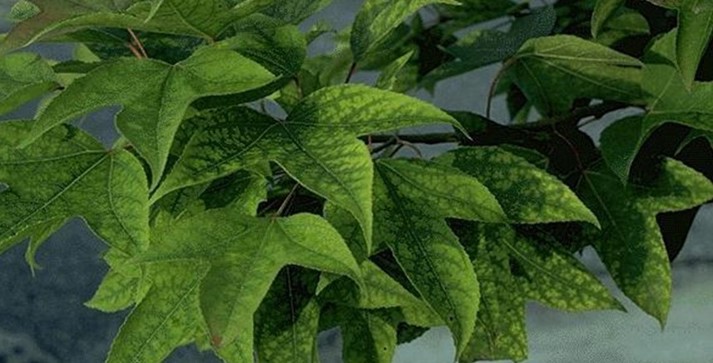
The Wonder that is Verdur®: When It Isn't Easy Being Green

Chlorotic symptons on Sweetgum leaves. All photos by Bill Seaman.

Published November 4, 2010, By KEVIN BASSETT and RUSSELL PETERS
For some trees – it’s not easy to be green.
Avid gardeners know that everything green starts with soil. Soil is the literal baseline where we begin our horticultural endeavors. It provides us with our cultural opportunities and constraints. While we frequently push our landscapes slightly past a soil’s parameters, we often concede to reality. Much of our north central Texas soil is the remnants of a massive blackland prairie that once supported native grasses that grow shoulder high. We have highly expansive black clay that is derived from the fractured white limestone that lies beneath. It has always been a mystery that white stone can produce black dirt, but it does. And, because the soil origin is limestone, the soil’s character is alkaline.
Our native trees grow well in our alkaline soils. That is why they are “native”. However, as gardeners, we are rarely satisfied with only growing plants, and particularly trees indigenous to our soils. Nature has provided us with too many beautiful trees to limit our landscapes to a plant palette of strictly natives. Your local nursery or garden center provides a broad range of “adapted” plants, of which many were introduced hundreds of years ago.

Iron deficiency in a Sweetgum.
Part of the gardening ethic is learning that some plants are more adaptive than others are. This is particularly true with our trees. We do what we can to modify our soils to accommodate our trees. We dig an adequate planting hole and add peat moss or compost to the backfill. We mulch and fertilize with specific additives. In some urban situations, the native soil is completely replaced by a more suitable media. As trees grow, we find that all the preparation is not enough. Sweetgum trees turn yellow when it is not fall, River Birch looks more like River Bleached, and Red Oaks of east Texas provenience appear to be dead Oaks.

Iron Chlorosis in a Red Oak.

Iron Cholorsis in a Pin Oak.
Interveinal chlorosis is the technical term. It means the elemental iron that is essential for the manufacture of chlorophyll is not available to the tree. In mild cases, leaf tissue is light green while the leaf veins remain dark. In moderate cases, the leaf color is yellow, frequently with brown margins. The extreme cases display white leaves.
Arborists have a recently introduced tool to address chronic interveinal chlorosis. Verdur® is a form of iron that is immediately available to the tree. Not only is the green-up rapid, we find a single application relieves the yellowing conditions for about three years. Verdur is applied into the tree’s root flares by a process called macro infusion. It is a process very similar to that used when treating trees for Oak Wilt. The tree’s vascular system transports the iron into the canopy where it aids in the manufacture of chlorophyll in leaves. Green leaves are healthy, energy producing leaves.
While Verdur produces excellent aesthetic results, it does not change the origin of the horticultural challenge. It does not alter the inherent character of your soil. It bypasses the need for the elemental iron in the soil to be available to the plant.
Verdur is a great tool for treating chlorotic trees that are deemed too large to fail. We find the most effective time to apply Verdur is during the dormant season (November, December, and January). Contact your arborist to see if Verdur is appropriate for your trees.

